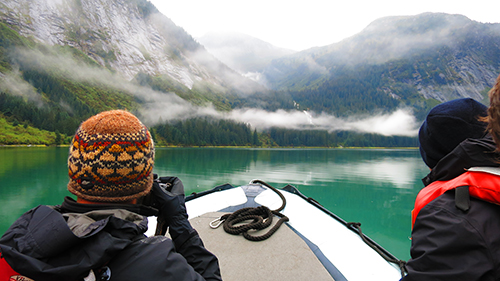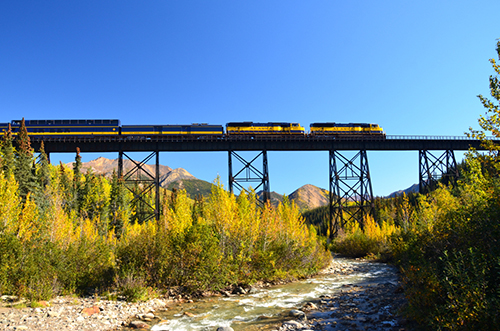Whether you travel by land or by sea, Alaska is home to a stunning and sublime supply of natural resources and wildlife.

By Boat
Standing on the deck of the ship, the massive blue glacier towered above us. Among the 80-plus passengers, there was a collective silence of awe, broken only by the regular cracking thunder of a piece of ice calving off the glacier, a delayed sound heard seconds after its visible splash into the frigid waters below. This is Glacier Bay National Park in Alaska.
The boat and people onboard seemed dwarfed beneath the powerful, 12-mile-long Johns Hopkins Glacier, one of the few Ice Age relics in the world that is still advancing rather than shrinking. In fact, during the past 350 years, the glacier has grown and retreated down the 65-mile length of the inlet, culminating at the solid, 250-foot-high, 1-mile-wide block of ice. It was a moment when we realized you do not inhabit a place, but the place inhabits you.
Glacier Bay National Park in Alaska, which naturalist John Muir called a “temple of nature” when he explored it in 1897. Today, it remains one of the last truly pristine places in the U.S., largely untouched by human development. Muir was so struck by the solitude, remote beauty and purity of Glacier Bay that he instantly sought its protection, a move that led to the creation of the National Park Service.
 Covering more than 3 million acres, the park is part of a 25-million-acre World Heritage Site located in Alaska’s Inside Passage, and is home not only to the constantly changing glacier, but also to rugged mountains, wild coastlines, fjords and even a temperate rainforest.
Covering more than 3 million acres, the park is part of a 25-million-acre World Heritage Site located in Alaska’s Inside Passage, and is home not only to the constantly changing glacier, but also to rugged mountains, wild coastlines, fjords and even a temperate rainforest.
While several cruise-ship companies offer itineraries that include visiting the park, the only way to get this up-close and personal with the glacier is on a small ship, like the UnCruise Adventure Safari Endeavor that I and my fellow passengers spent a week on. Such a small ship (It carries a maximum of 84 guests.) not only allows sightseers to experience parts of Alaska’s wild beauty that can only be seen by water, but it also allows access to places the gigantic cruise ships simply can’t go.
One such hard-to-reach spot is ominously called Ford’s Terror. The history behind the name dates back to 1899, when a naval crewmember named Ford rowed into the narrow waterway while conducting a survey. The bottleneck entrance eventually opens up to a large expanse of serene water nearly a mile wide, but Ford was not thinking about high tide, nor what would happen when those waters rushed through the tight canyon walls. The story goes that a powerful, unstoppable wall of water rushed through and trapped Ford with terrifying force. He frantically paddled the strong current for six hours before escaping, inadvertently giving this section of the Tracy Arm and Endicott Arm fjords its name.
Venturing into Ford’s Terror requires absolute perfect conditions of weather combined with tidal timing. Fortunately, on the day Safari Endeavor approached, we had both of these factors tipping in our favor. I could tell the place was something rare and special by the visible excitement of the crewmembers. Our guide, Phil, was wide-eyed and grinning uncontrollably as he led us into the remote, silent area. He told us this—one of the last Alaskan sailings of the season—was the first time they had been able to access Ford’s Terror all year.
A guided cruise is just one of the magnificent ways to explore the many nearly inaccessible places of the 49th state, to experience incredible wildlife sightings of whales, bears, seals, bald eagles, sea otters and a dizzying array of bird species.
One early morning in the bay of Port Houghton, I heard excited shouts and footsteps. Upon emerging from the cabin, I discovered several pods of humpback whales, with a dozen or more animals in each, feeding all around the ship. Their backs glided up out of the water as they ate—once, twice, maybe three times—until the final dive, when their flukes came up out of the water in a truly awe-inducing sight. The whales stayed with us the entire day, along with playful sea lions, as we explored the tidal pools onshore with a guide and went kayaking in the bay.
Of course, with Alaska’s massive size, there are plenty of land-based adventures to be had as well. The state is home to the three largest parks in the National Park System: Wrangell-St. Elias, Gates of the Arctic and Denali. The last is perhaps the most famous of these, due to the mountain of the same name, which tops out at 20,310 feet and is the highest peak in North America.
 By Train
By Train
A fun and exciting way to explore Alaksa is by train. Traveling by locomotive conjures images of early explorers riding the rails and having grand adventures as they discovered new frontiers. Local tracks were laid starting in 1903, in the only ice-free coastal town in the state, Seward. Eleven years later, the U.S. Congress authorized construction of 470 miles of railway line from Seward north to Fairbanks.
Today, the Alaska Railroad provides travelers with a fun, informative and exciting adventure over land, offering up some of the most stunning views you’re likely to ever see from a train. Along the way, extremely knowledgeable guides provide narrative commentary, from facts about the nature and wildlife to stories of Alaska’s history and its people.
I took the Denali Star Train, which ventures down one of five Alaska Railroad routes and departs each day in the summer for a 12-hour journey between Fairbanks and Anchorage with several stops along the way, one of which is Denali National Park.
The weather on the morning we approached Denali was beautiful. As we rounded a corner, suddenly, there was the mountain, rising above everything in its majestic splendor. This clear sighting was such a rarity that the conductor stopped the train for a few minutes so everyone had a chance to view—and photograph, of course—the mighty snowcapped mountain.
Once we arrived at the park, I de-boarded for a two-night stay at the Grande Denali Lodge, a short shuttle ride from the visitors’ entrance to the 6-million-acre park.
Denali’s wilderness is only accessed via one 92-mile-long road, a path that traverses through a low-elevation forest to the high alpine tundra, culminating at the base of the daunting mountain and the start of a smattering of trailheads.
The optimum way to explore the majority of Alaska’s prominent beauty is to enjoy it by both land and sea. As Glacier Bay Park Ranger J.T. McLaughlin put it, the park system is a reminder that nature belongs to all of us.
“The natural world is all around us every day, but we may never see it,” McLaughlin says. “We come somewhere like this to see these wild places and remember our origins, [to]remember where we came from and what we belong to.”


